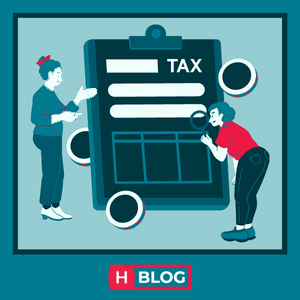
Flat-rate taxation (or “átalányadó”) is currently the most popular tax regime among freelancers with a relatively low annual revenue (below HUF 28 million). It is not as straightforward as KATA, but it is still simple and low cost compared to other tax regimes. But how much does it actually cost? Read on to get an overview and some examples.
The name flat-rate taxation itself is a bit misleading. It is not the tax itself that is flat-rate, but the calculation of your net income, based on which you pay your taxes. All in all, you will end up paying between 0% to about 30% of your revenue in taxes, which is still very favorable compared to the usual employment tax burden. Below, you can find the different tax items and limits that you will need to consider.
On a classic profit tax scheme, you would pay taxes on your net income, which is your revenue minus your expenses. For that you must collect all your expense invoices and report them to the Tax Authority alongside the invoices you issue. Under flat-rate taxation, however, it is simply assumed that a certain percentage of your revenue is your expense, and you do not have to collect invoices to support your claim.
This flat rate for expenses depends on your activity, and can be between 40-93%. The most widespread option is the 40% expense rate, where you pay taxes on 60% of your revenue. (In essence, it is assumed that 60% of your revenue is profit after expenses, so this forms your tax base.)
Below you will see calculations for freelancers with the 40% expense rate, with a registered seat where local business tax is the maximum, 2%. You will see that there is a “critical” monthly revenue, under which you pay a monthly minimum contribution.
In our example, we use a freelancer with an activity that does not require a high school diploma or any special qualification. Some typical fields include food delivery or construction work. For them, the “critical” monthly revenue is HUF 435,000, under which you pay a monthly minimum contribution around HUF 80,000.
For jobs that require at least a secondary education, such as teacher, architect, or doctor, the “critical” monthly revenue is HUF 550,000, and the minimum contribution is around HUF 100,000.
Click here for a table in PDF.
You pay the minimum contribution, which is ca. HUF 80,000 monthly. Above that:
You pay the minimum contribution, which is ca. HUF 80,000 monthly. Above that, you pay 10.44% of your revenue in taxes. This includes:
Until you hit the tax-free limit, you pay 20.34% of your revenue in taxes. This includes:
You do not pay the personal income tax.
Once you have hit the tax-free limit, from that point onwards you pay 29.34% of your revenue in taxes. This includes:
Until you hit the tax-free limit, you pay only 1.44% of your revenue in taxes. This includes:
The first HUF 2.32 million revenue is free of personal income tax, while the basic social security and the social security contribution and the social contribution tax is covered by your main job.
Once you have hit the tax-free limit, from that point onwards you pay 29.34% of your revenue in taxes. This includes:
Based on the above, it is obvious that flat-rate taxation is most favorable to those who are self-employed as a side job. If your yearly revenue remains under the tax-free limit, you pay hardly any taxes.
Please note: in this sense, being a full-time student counts as a full-time job. Foreign students in Hungary with a student residence permit are normally full-time students, and as such can take advantage of freelancing under flat-rate taxation as a side job.
If you are self-employed as your full-time job, flat rate taxation is taxed around 30% of your revenue, which is still quite favorable. However, this is only true if your monthly income is at least HUF 435,000. Otherwise you must pay minimum contributions for each month, and the lower your revenue, the higher your burdens will amount to with respect to your income.
At this point, you can already see that the first thing to consider is the expense rate applied. It is not a matter of choice: it will depend on your activity. 40% is the lowest, and also the most widespread expense rate, but it can be higher only if you are in retail or agriculture.
The other important factor is whether you are freelancing as your full-time job or as a side job. Full-time freelancers must pay social contributions (health and pension, etc.) every month based on the minimum wage – even if they had no revenue. Those freelancing as a side job pay social contributions only if they have revenues.
At the same time, any net income up to 50% of the yearly minimum wage (HUF 1,392,000 in 2023) is free of 15% personal income tax. Side job freelancers do not pay taxes on this sum at all (so up to this amount their income is tax-free), while full-time freelancers only pay the 18.5% social security contribution and the 13% social contribution tax up to this limit (but not the 15% personal income tax)
You must also pay the local business tax, the base of which is 120% of your income. The tax itself is 0-2%, depending on where your business is registered.
Taxes and contributions are reported and paid quarterly. This way if you do not have revenue every month, you are not stuck paying taxes on zero income and then paying full taxes on your actual income, but distribute your income over three months and pay taxes accordingly.
We at Helpers provides assistance with business and immigrations to foreigners living and working in Hungary. We are trying to make your life easier not only with services related to company formation, accountancy, and residency application, but with simple explanations for Hungarian regulations.
Can we help you? Fill in the form below to get in touch today.
Was this article useful? Follow us on Facebook to never miss an update.
CONTACTE CON NOSOTROS

Company modification is the official procedure through which a lawyer’s help you can change the core data of your Hungarian company with the Company Registry. One of the cases when you need this procedure is when your company is hiring an auditor.
Leer más
The deadline to report your personal income tax in Hungary is coming up: 21 May 2024, Tuesday. At the same time, you can also donate 1+1% of your taxes. This costs you nothing, and you can support a good cause.
Leer más